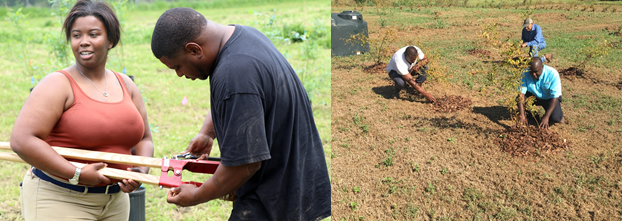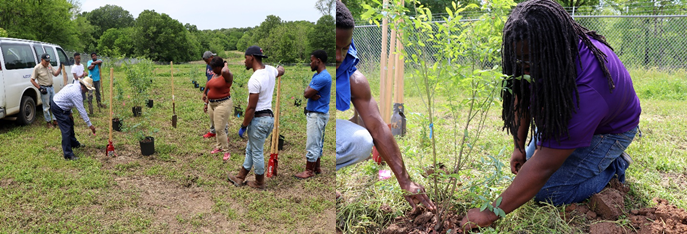Agroforestry practices have the potential of enhancing food production and environmental quality particularly in the era of climate change. According to USDA Forest Service statistics (Oswalt, et al., 2017), approximately 61% of Mississippi land is forested, hence the state offers a unique opportunity to study how agroforestry systems can improve food production and environmental quality. Notably, South west Mississippi is home to many small-scale limited resources farming communities and this experiment will provide new insights about the potential food production and environmental quality benefits of horticultural based agroforestry. For producers with limited resources, diversification of agricultural practices is key to improving sustainability of farm resources. Indeed, diversification has been acknowledged for its role in enhancing sustainable growth compared to monocrop production system in the rural sector (Barghouti, et al., 2004)
Agroforestry system is consistent with the model of sustainable agriculture in terms of environmental conservation. Diversification of cropping systems and efficient use of natural resources help to restore and enhance environmental quality. Agroforestry has the potential to contribute to both climate change mitigation and adaptation by sequestering carbon, reducing greenhouse emissions, enhancing resiliency, and reducing threats while facilitating migration to more favorable conditions in the highly fragmented agricultural landscapes. For example, a 13-year-old alley-cropping system in Ontario, Canada, was found to have 11% to 41% more carbon, depending on tree species, compared to monocropping plots (Peichl et al. 2006). Indeed, soil carbon stocks have been demonstrated to generally be larger in agroforestry systems compared to conventional cropping systems (Kumar and Nair 2011).
In addition, agroforestry techniques have the potential to increase soil porosity, reduce runoff, and increase soil cover, which can improve water infiltration and retention in the soil profile thereby reducing moisture stress in low rainfall years (Jose et al.,2009). The newly established pecan tree-based agroforestry at Alcorn State University (ASU) in Mississippi is a scientifically designed mixed cropping system with annuals, biennials, and perennials to enhance food production and improve environmental quality (Fig 1). Detail description of the plots layout and experimental designed is on the next section (study site description). The benefit of agroforestry system includes provision of food, fuel, timber and various agricultural products, in addition to restoring the equilibrium in the ecosystem and contributing to agricultural conservation (FAO World Forestry Congress, 2005; Jose, 2009). Additionally, ASU agroforestry experiment will enhance research, teaching and extension concerning environmental, economic and social benefits of agroforestry at Alcorn State University. Hence, the overall objective of this experiment is to assess the impact of horticultural based agroforestry amended with organic and inorganic sources of fertilizers on crop production and environmental quality. Specifically, we are collecting data on crop yields, soil health and water quality.
Study Site Description
The study area is located in Alcorn State University, Lorman, MS (31°53'44.8"N 91°09'14.4"W) and the soil is classified as Loring and Memphis silt loams. The experiment site was established in the summer of 2018 with annual vegetables crops (Fig 2) and perennial crops were planted in the spring of 2019 (Fig 3). Pecan trees were used as woody perennials and vegetables, blueberries and muscadine grapes were planted between the pecans. Row spacing between pecan trees is 90 ft. Each cropping system has four treatments replicated four times in a randomized complete block design.
 Figure 1. Performing field cultural practices on crops under agroforestry system
Figure 1. Performing field cultural practices on crops under agroforestry system
 Figure 2. Dr. Mccomb preparing for installation of wireless NPK sensors on the annual crops plots.
Figure 2. Dr. Mccomb preparing for installation of wireless NPK sensors on the annual crops plots.
 Figure 3. Preparation and transplanting of blueberries in the agroforestry field.
Figure 3. Preparation and transplanting of blueberries in the agroforestry field.
Preliminary results
Preliminary results did not show any significant differences on soil properties at P ≥ 0.05 in the first season (Table 1). The lack of a significant difference can be attributed to the short term nature of the experiment (< 1 yr.). We hypothesize that soil properties will improve significantly in plots amended with organic manures compared to urea prill and control after 3-yrs of treatment application.
Table 1. Soil properties under vegetables plots
|
Treatments |
pH |
EC |
P |
K |
Ca |
|
|
|
μS/cm |
…......…............lbs./Acre…................... |
||
|
Control |
5.87 |
37 |
95 |
238 |
2809 |
|
Poultry Litter |
5.85 |
43 |
83 |
219 |
2697 |
|
Cow Manure |
5.95 |
56 |
95 |
206 |
2951 |
|
Urea |
5.85 |
56 |
103 |
215 |
2824 |
Soil active carbon and water stable aggregates did not differ significantly at P ≥ 0.05 among the treatments after one season of the experiment (Fig.4). Notably, changes in soil properties have been observed to take up to/on average/somewhere around 5 years depending on soil initial conditions (Kibet et al., 2016). Soil active carbon is an indicator of the small percentage of soil organic matter that can serve as sensitive indicators of changes in management-induced soil quality, include microbial biomass carbon (Islam and Weil, 2000). While water stable aggregates is a measure of soil resistance to water erosion and also an indicator of a soil’s resistance to compaction.

Conclusion
Preliminary results suggest that one yr. of amending soil with organic and inorganic sources of nitrogen in a Memphis silt loam in South west Mississippi under agroforestry did not affect soil properties. Thus, our results suggest that there could be limited or no impacts of organic and inorganic fertilization on soil properties within the above timeframe and soil type. We hypothesize that the lack of soil properties response to fertilization may be attributed to the short term nature of the experiment and use of a highly productive soil. The experiment is ongoing and we will continue to monitor changes in soil properties, crop yields and water quality.
Acknowledgement
This project is being funded by USDA-Evans Allen Grant (Environmental Science Cluster research group). We also like to thank our school administration, support staff and students for their efforts in the experiment.
References
Barghouti, S., Kane, S., Sorby, K., & Ali, M. (2004). Agricultural diversification for poor: guidelines for practitioners. Agricultural and Rural Development Discussion Paper1, Agriculture and Rural Development Department, World Bank.
Food and Agriculture Organization (FAO). 2005. State of the world's forests. FAO, Rome. 166 p.
Islam, K.R., and R.R. Weil. 2000. Soil quality indicator properties in mid-Atlantic soils as in¯uenced by conservation management. J. Soil and Water Conserv. 55:69±78.
Jose, S., E.J. Holzmueller, and A.R. Gillespie. (2009). Tree-crop interactions in temperate agroforestry. In North American Agroforestry: An Integrated Science and Practice. 2nd ed., ed. H.E. Garrett, 57-73. Madison, WI: American Society of Agronomy, Inc.
Jose, S. (2009). Agroforestry for ecosystem services and environmental benefits: An overview. Agroforest. Syst. 76, 1–10.
Kibet, L.C., H. Blanco-Canqui, R.B. Mitchell, and W.H. Schacht. 2016. Root biomass and soil carbon response to growing perennial grasses for bioenergy. Energy Sustain. Soc. 6:1.doi:10.1186/ s13705-015-0065-5
Kumar, B.M., and P.K.R. Nair, eds. (2011). Carbon Sequestration Potential of Agroforestry Systems: Opportunities and Challenges. Vol. 8: Advances in Agroforestry. New York: Springer
Oswalt, S.N., Smith, W.B., Miles, P.D. (2017). Forest Resources of the United States, 2017: a technical document supporting the Forest Service 2020 RPA Assessment. Gen. Tech. Rep. WO-97. Washington, DC: U.S. Department of Agriculture, Forest Service, Washington Office, Washington, DC,
Peichl, M., N.V. Thevathesan, A.M. Gordon, J.Huss, and R.A. Abohassan. (2006). Carbon sequestration potentials in temperate tree-based intercropping systems, southern Ontario, Canada. Agroforestry Systems 66:243-257.



